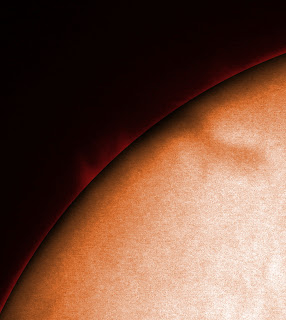I reprocessed a full
disc lunar photo from August 24th 2011.
Thursday, January 31, 2013
Wednesday, January 30, 2013
Widefield summer constellation shot reprocessed
I took a widefield
shot of the summer constellations, including the faint pair of Delphinus and
Sagitta.
Constellation shots January 29th
I did a series of
constellation shots from 1900 to 1930 GMT. The eastern sky was covered by cloud
but the area surrounding Orion seemed quite promising, so I decided to
concentrate there. In the first shot, Lepus and Canis Minor are also visible.
Although I couldn’t
see the other stars in Canis Major (apart from Sirius) the main ones came out
in the photo, even though it was low in the sky.
Monday, January 28, 2013
Moon through binoculars
I was out again at
2100 snapping the Moon through my binoculars. It was past full but Tycho’s rays
were still dominating the moonscape and there was some terminator detail near
Mare Crisium.
Zenith shot from Portugal
In the Portugese
evening at 1930 GMT I took an overhead shot and it showed Perseus, Cassopiea
and the Pleaides.
Sunday, January 27, 2013
Solar "white light" shot reprocessed
On August 21st I also took a shot of the solar disc through my Maksutov using the normal capture and processing procedures.
Saturday, January 26, 2013
Sunspot photo
I checked the Sun with the bins early morning and couldn't spot activity. The Big Bear images looked quite bland, too. I returned out at 1040 GMT with a telescope and camera.
I only saw and
captured two sunspots but it was just nice to be out again. Usual method with
the Maksutov. Considered the spots too small to want to attempt webcamming
them.
Thursday, January 24, 2013
Wednesday, January 23, 2013
Fake Galaxy Cluster
I noticed that the
sunspot group I captured earlier in the month reminded me of some of the
galaxies I had seen. I reprocessed the best close-up to produce a fake galaxy
cluster.
Tuesday, January 22, 2013
Monday, January 21, 2013
Sunday, January 20, 2013
Friday, January 18, 2013
Jupiter shots reprocessed
In the absence of
clear sky, I decided to revisit the Jupiter shots of earlier in the month. I
experimented with splitting channels and was amazed to see the blue channel
show the most detail.
Solar image reprocessed
August 21st
2011 was a very prolific day and the next sequence of reprocessed shots feature
the Sun in hydrogen alpha light, starting with the full disc.
Wednesday, January 16, 2013
Moon January 15th
I was hoping to start
on the Moon earlier but, unfortunately, had to take my daughter to Casualty. At
least she wasn’t as bad as feared and the Moon was still there at 2000 GMT,
although getting lower. I did some full disc shots and some close-ups with the
webcam, without the 2X Barlow lens. The full disc image was the best 5 of 10
frames.
The first photo from
the webcam runs is a mosaic of 3 stacked imaging runs from Registax 5 combined into a single image using
Microsoft ICE, with further processing done using Paintshop Pro and GIMP.
The second image
consists of the result of a single imaging run.
The third image was
composed from 2 separate imaging runs.
The fourth picture was
taken from a single imaging run.
The next picture was
also taken on a single imaging run.
The mid-region near
the terminator showed a lot of detail from a single run.
Another single run
produced some detail.
The final photo was a
composite of 3 imaging runs.
Tuesday, January 15, 2013
Solar Drawing January 15th
I spotted Venus just
above the horizon from the car on the way to work.
At lunchtime I bin
scanned the Sun and it looked rather different from the view on 13th
but still very active.
Sunday, January 13, 2013
Sun January 13th
The day had started
brightly but by the time I was ready to snap the Sun in hydrogen alpha light at
1025 GMT, thin cloud had covered the Sun. Visually, the only stand-our features
were the sunspots I could see much better in white light anyway. I took some
full disc and close-up (of the sunspot area) shots in the hope of getting
usable data. Only the full disc shot showed anything useful at all.
Having sorted out one
or 2 chores, I had another go at the Sun with my PST at 1140 GMT. It was quite
incredible in the clearer conditions with some activity all over the disc. The
sunspot region looked quite amazing and I could see a small prominence. I took
full disc shots and close-ups of the sunspot area and prominence area.
At 1150 GMT, I did a
full disc imaging run with the Maksutov but could only capture a few frames
before the battery ran out. 4 frames were stacked with Registax 5 (Registax 6 “froze”)
and further processing was done using Paintshop Pro and GIMP.
At 1200 GMT I was
webcamming the Sun with the Mak and SPC880. I started off with the 2x Barlow
lens but seemed to get sharper sunspots without it. I managed to see a lot of
detail on the laptop screen, with the sunspots showing irregular patterns and
penumbral shading.
As it turned out, the
shots without the Barlow lens worked best and the others I discarded. I tried
to stitch and stack the files I obtained from Registax but was unable to get
higher resolution, so here are the results.
Saturday, January 12, 2013
Friday, January 11, 2013
Thursday, January 10, 2013
Zenith shot January 11th
It was cleared when I looked out at 0640 GMT. Ideally, I’d have done a long session but I had to travel for a training course. I took a zenith shot and was pleased to catch Alcor/Mizar and a satellite.
Wednesday, January 9, 2013
Tuesday, January 8, 2013
Subscribe to:
Comments (Atom)















































